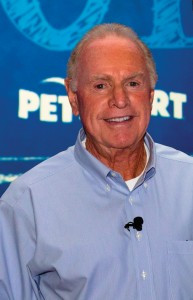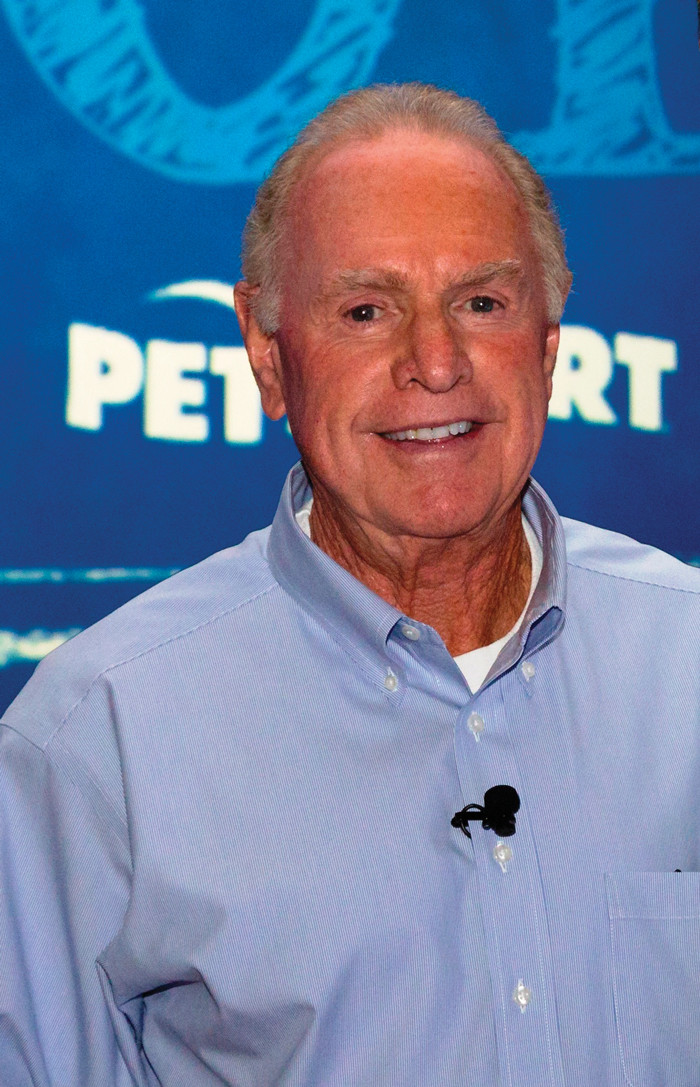A Look Back: The Birth of PetSmart
Pet Age Staff //June 1, 2014//

The pet retail industry is projected to reach an astounding $60 billion in sales this year.
These sales come from a variety of resources, including big-box stores, small-chain stores, pet boutiques, grocery stores, etc.
It is fascinating to reminisce about the early 1980s when pet retail purchases were in the $5 billion range, in large part from grocery store pet food sales.
Jim Dougherty is no stranger to the history of the pet retail industry. Dougherty watched it happen from the inside. His unique vision saw a need to expand the pet food segment, build on that foundation and bring customers back to buy consumables more often.
An opportunity came in 1980, when the owner of a feed manufacturer approached Dougherty to establish Petfood Supermart in Las Vegas. Dougherty accepted and, along with his wife, Janice, moved to Las Vegas.
The opportunity did not come without major obstacles. The building was on a dead-end street behind a lumber yard with no store front. Undeterred by these shortcomings, Dougherty transformed the empty warehouse and Petfood Supermart opened for business in 1980. It became a profitable enterprise.
That success resulted in the expansion of Petfood Supermart to Phoenix, Ariz. Dougherty and his wife settled in Phoenix and opened a third Petfood Supermart, which was an instant success. Dougherty realized the opportunities in Las Vegas and Phoenix
were similar: Research indicated there was a huge dog population, and grocery stores had the market share of pet food sales. Dougherty realized this was another opportunity he could not pass up; it was time to start his own business and take the pet retail warehouse concept to a new level. Ironically, in 1992, Petfood Supermart was the first acquisition for PetSmart.
Armed with the financial backing of a major shirt manufacturer, Dougherty assembled a management team that consisted of a group of dedicated individuals who had a passion and resolve that would propel the company to success.
Incorporating in 1986 as Pacific Coast Distributing, the short-term plan was to open two 20,000-plus-square-foot stores in the Phoenix area. The long-range strategy was to expand the business across the country. The plan was to lease vacant grocery stores and convert them into a warehouse setting.
Petfood Warehouse opened in 1987, welcoming customers and their pets, which was a first for the pet industry. This was truly a breakthrough because, prior to this, only service dogs were allowed in retail outlets. A second unique feature was added, pet adoptions. Local pet shelters brought homeless pets to the stores on a regular basis and would also hold adopt-a-thons.
The Petfood Warehouse mission was to create a solid customer base by providing them with grocery store brands and specialty brand foods. It would also provide customers with an endless supply of pet-related products, including collars, leads, beds, crates, bulk rawhide bones and more, under one roof.
Securing store sites became problematic.
Developers were concerned with the word “warehouse” in the store name. A name change was necessary and a contest was conducted, which allowed associates and customers to submit and choose the new name. Dozens of names were submitted. The winner of the contest: PetSmart!
Petfood Warehouse became PetSmart in 1989. Thus, two years after opening the warehouse-style pet retail store and with a new name, PetSmart was on a path to become the industry leader. By 1994, PetSmart had 100 stores across the nation.
Today, PetSmart operates more than 1,160 stores, pet hotels, Doggie Daycare Camps and made vet offices in stores commonplace.
In the 1980s the pet retail industry was in its infancy and innovation was limitless. PetSmart pioneered many concepts in an effort to provide customers with a one-stop shopping experience.
PetSmart’s focus was to meet the needs of the customer to make their shopping experience memorable. It was critical to hire associates with a passion for pets and provide staff with store product knowledge.
PetSmart’s culture was to have leadership from the checkout counter to the board room. This culture is what made PetSmart what it was and is today. The goal was to create a bond with the pet owner, their pet and PetSmart. This bond would bring the customer and their pet back to PetSmart for purchases of food, products and services. Innovative ideas and a commitment for customer satisfaction enabled PetSmart to carve out a unique market share in the pet retail industry.
There was a time when most pet product manufacturers would never sell direct to stores and the American Pet Product Manufacturers Association wouldn’t allow retailers to attend their annual trade show unless you had five stores or more.
Dougherty and PetSmart changed all of that and the revolution began.
In 2005, Dougherty founded Petsense, a chain of pet stores across the USA. Petsense, headquartered in Scottsdale, Ariz., has nearly 100 stores, is growing and setting a standard with smaller format stores, mainly in Southern USA locations.
The pet industry is changing daily and retailers have to change to meet the demands of their customers. In 1996, we had 12,000 retail pet stores in the USA and the prediction was that PetSmart would eliminate most of the competition. Today, there are still 12,000 retail pet stores in the USA.
If you ask this soft-spoken gentleman, he’ll say, “My career in the pet retail business has been a phenomenal experience. I have met countless individuals along the way with whom I am still in contact with. I have transformed many business relationships, connections which have been instrumental in my success, into long-lasting friendships. The pet industry and its evolution has been a fascinating segment of the business world, and I have been blessed to have been a part of it.”
The rest is history.



















